Abstract
In normal subjects it was possible to evoke tendon and Hoffman reflexes which were followed by late EMG responses with a latency of 150-250 ms after the reflex stimuli. Analysis of the covariations of reflexes and late responses revealed that muscle spindle sensitivity and strength of the preceding twitch are not essential factors in determining the occurrence of the late responses as opposed to excitability changes within the spinal cord. Inhibition of monosynaptic reflexes and facilitation of late EMG responses to vibration indicate a difference in central pathways. A polysynaptic pathway may be involved in the late responses.
Full text
PDF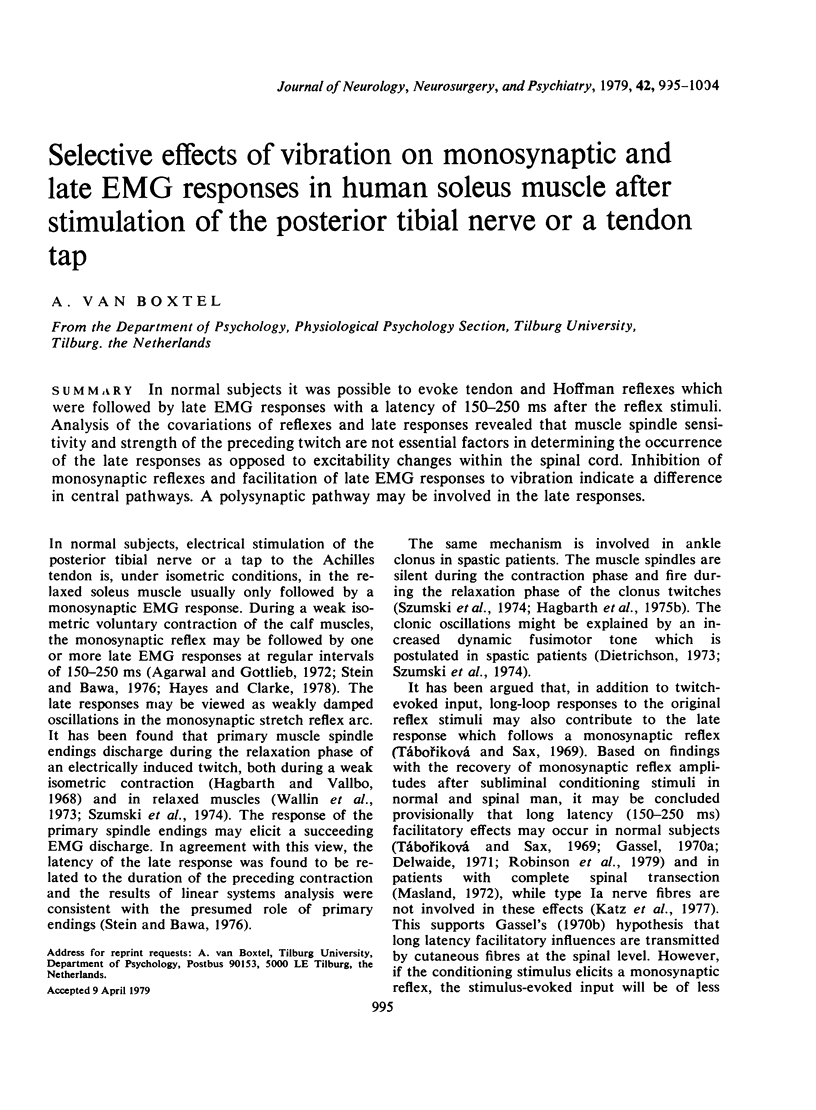
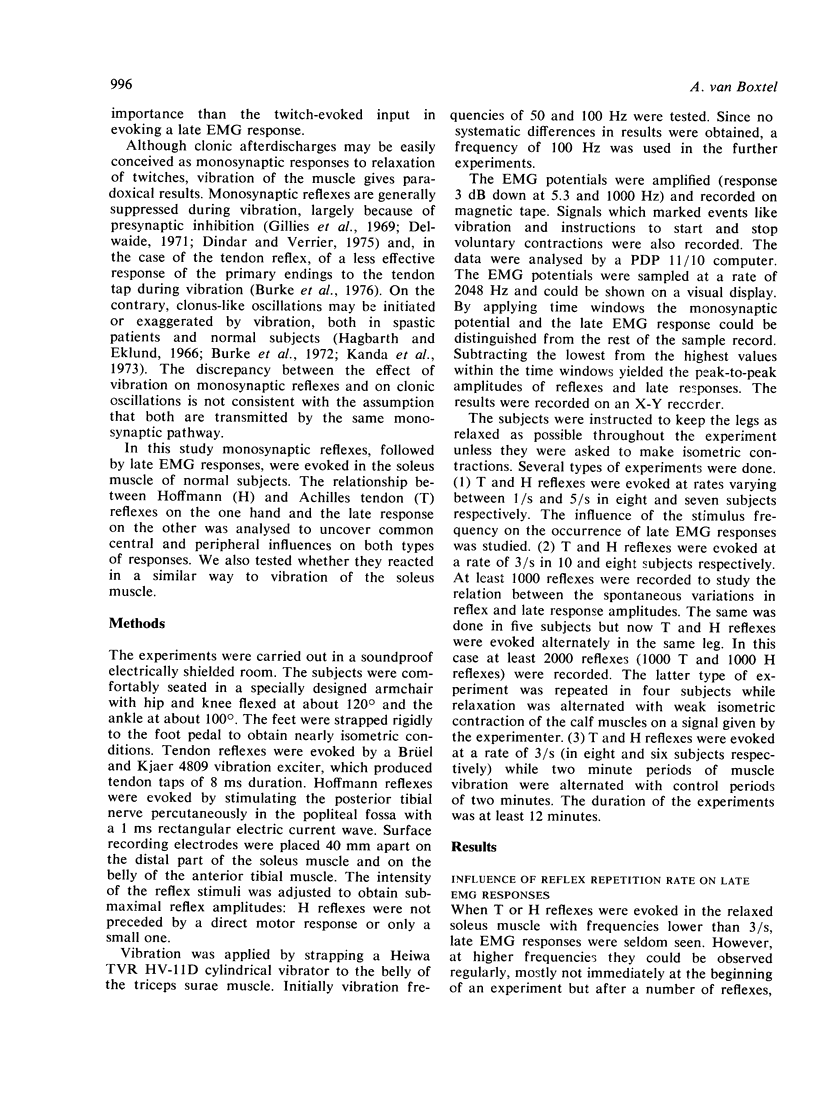
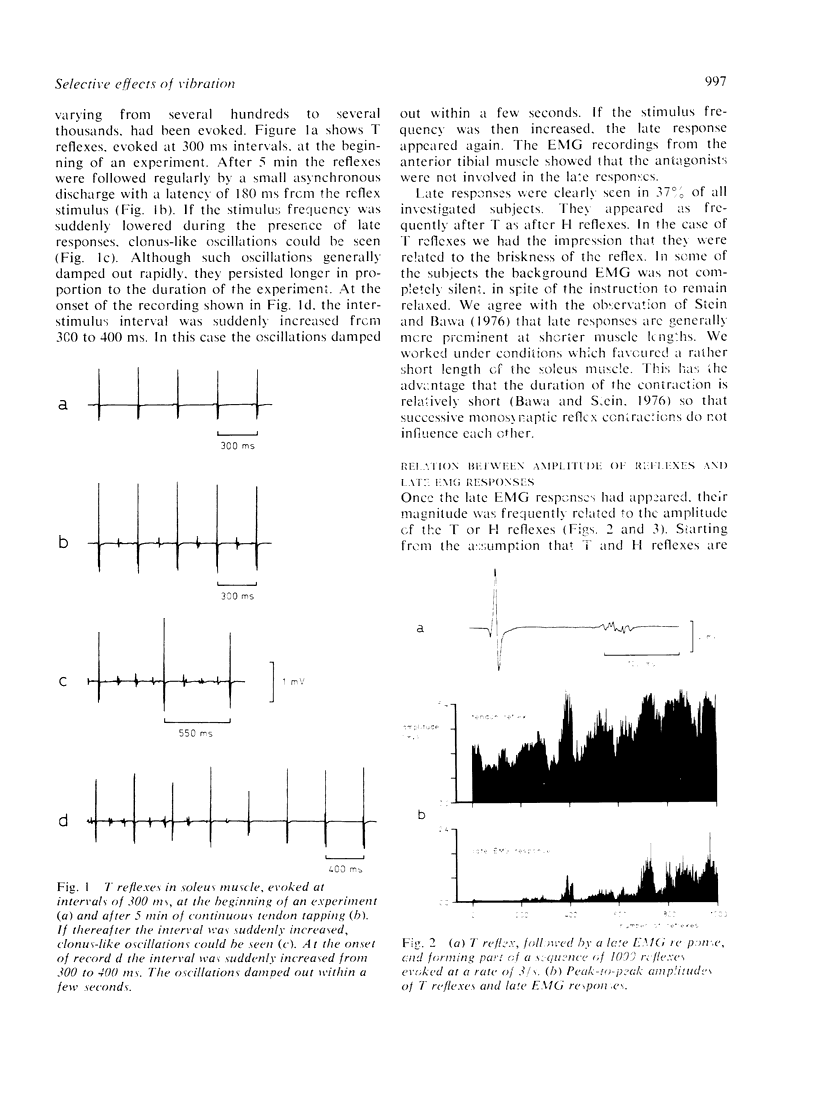
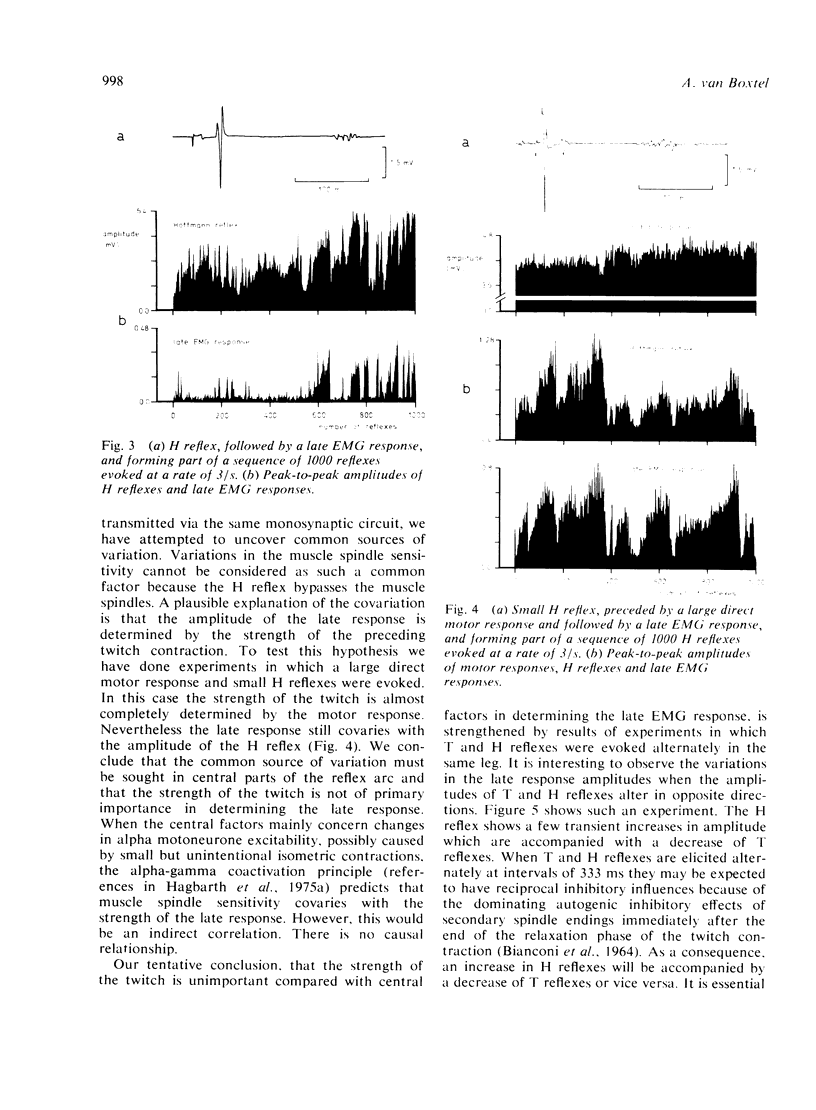
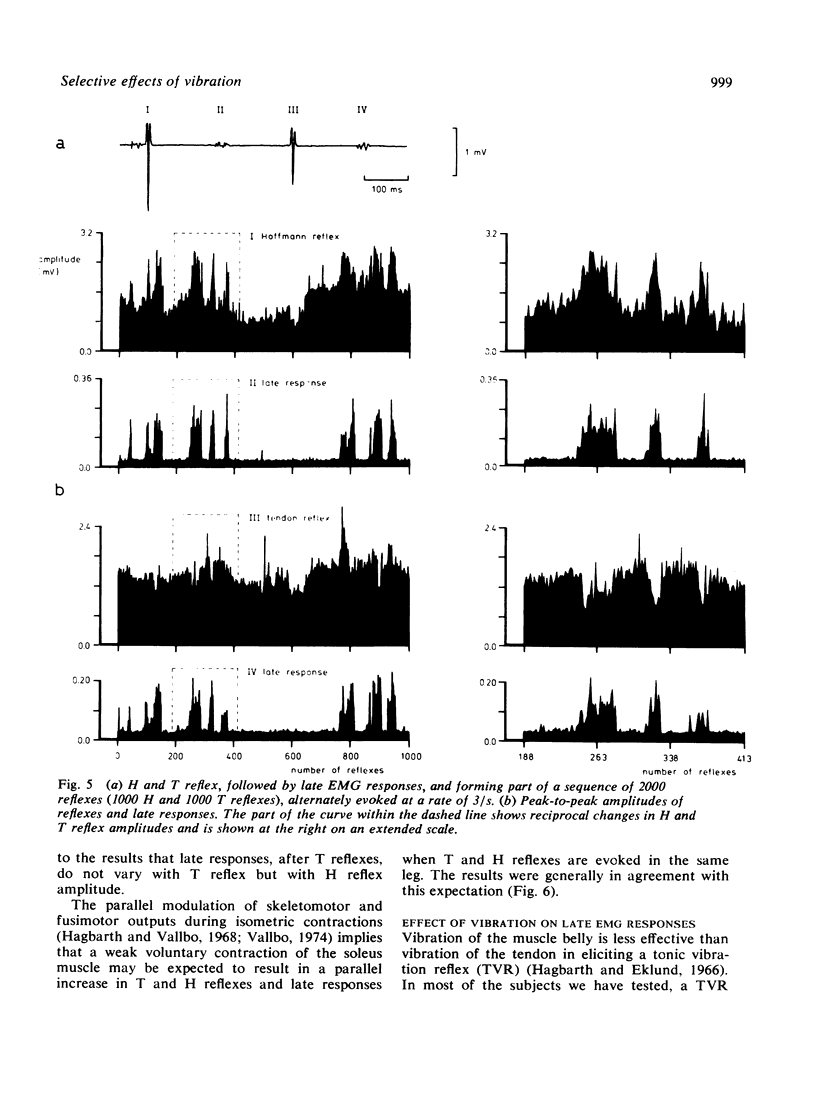
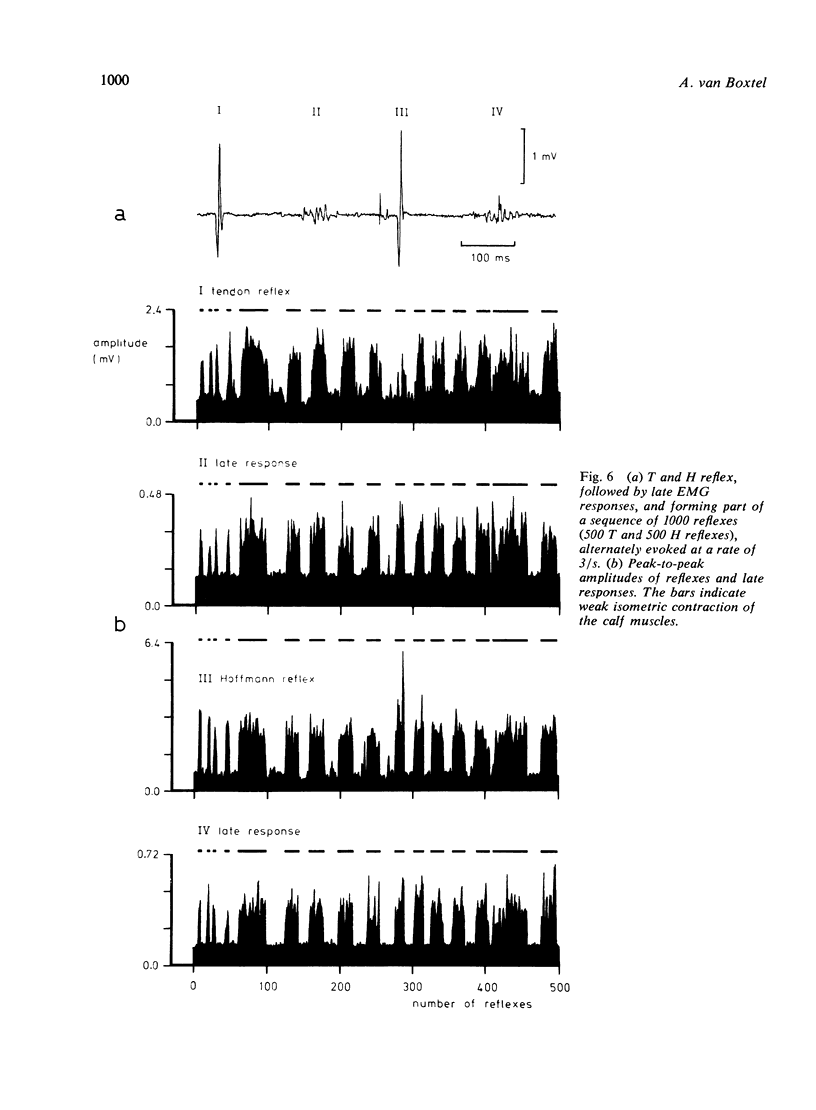
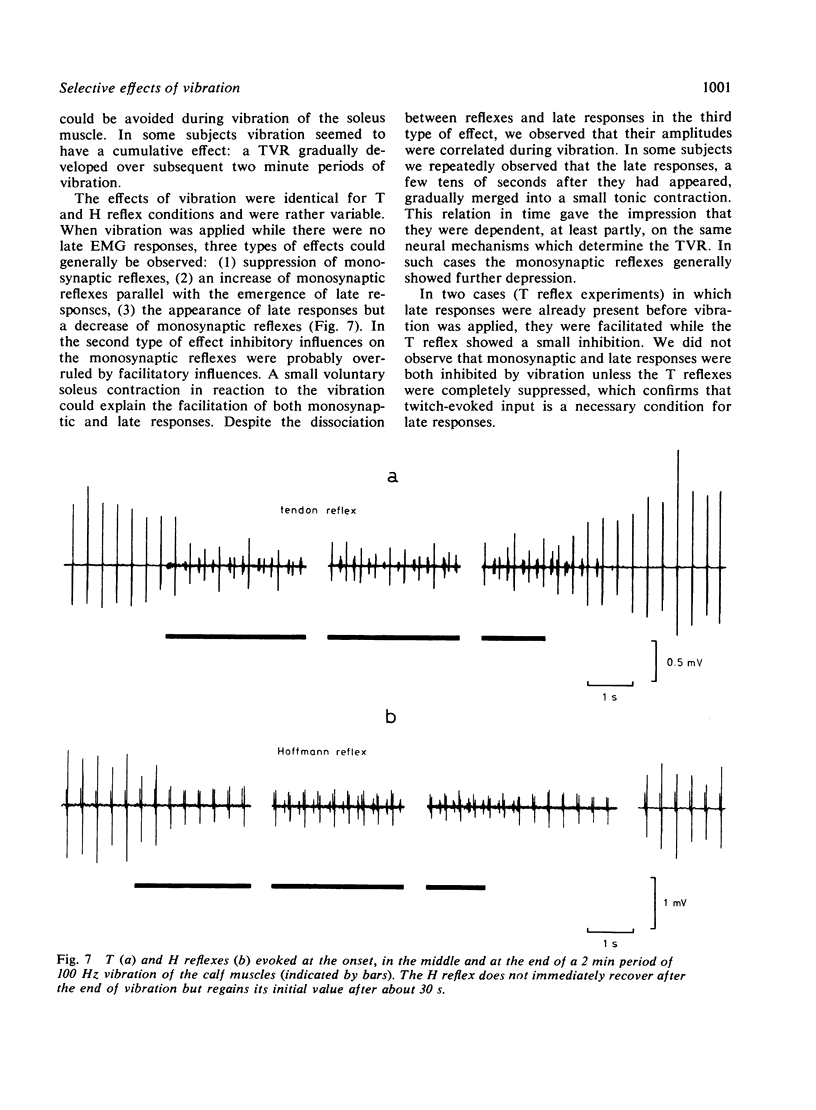
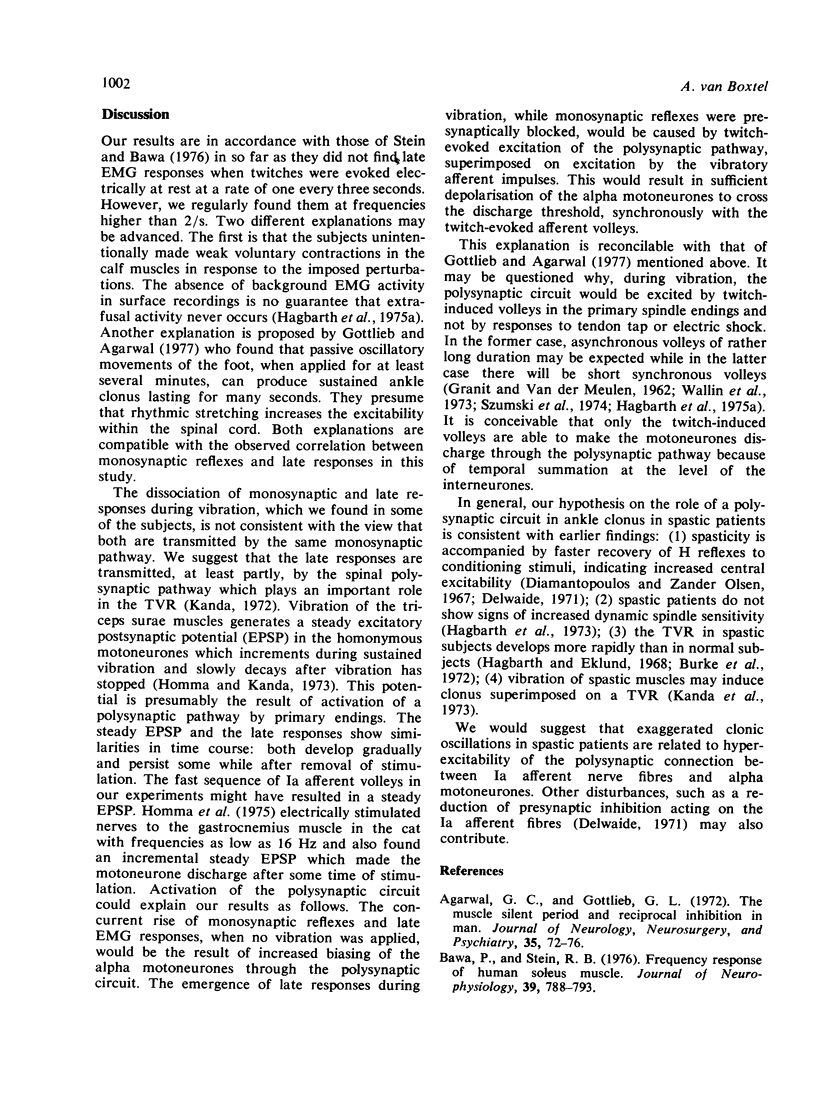
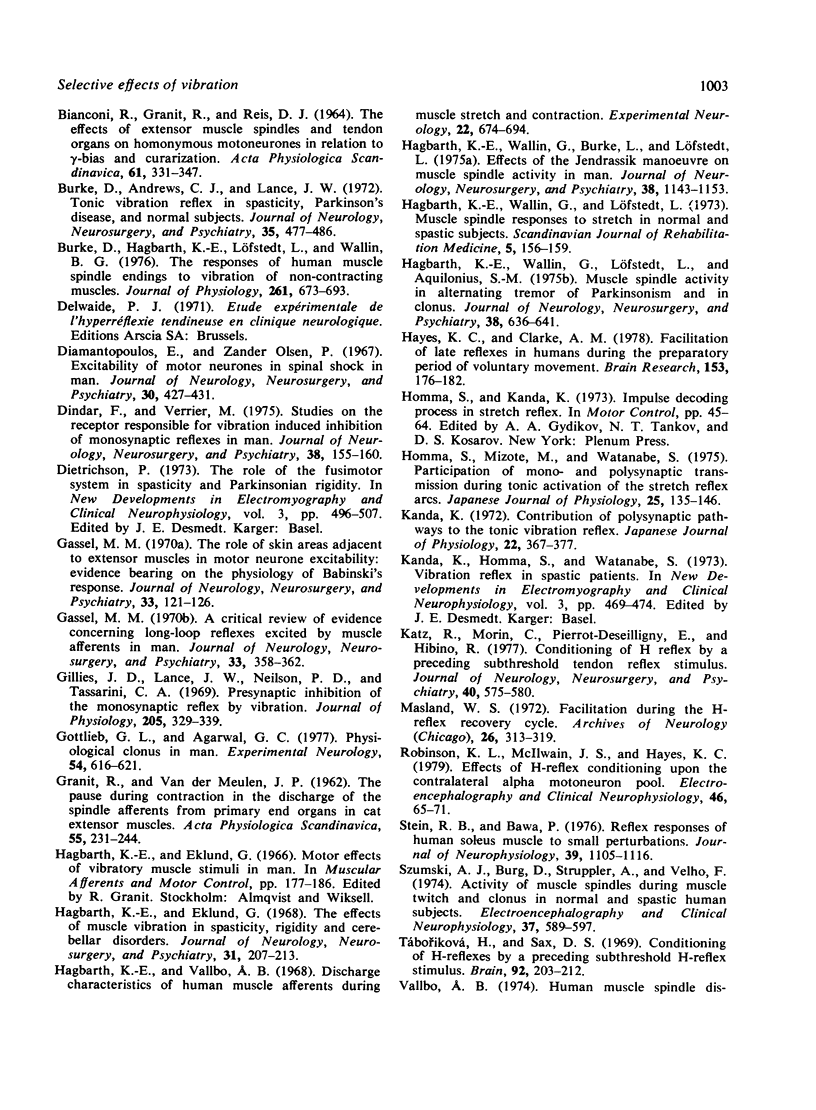

Selected References
These references are in PubMed. This may not be the complete list of references from this article.
- Agarwal G. C., Gottlieb G. L. The muscle silent period and reciprocal inhibition in man. J Neurol Neurosurg Psychiatry. 1972 Feb;35(1):72–76. doi: 10.1136/jnnp.35.1.72. [DOI] [PMC free article] [PubMed] [Google Scholar]
- BIANCONI R., GRANIT R., REIS D. J. THE EFFECTS OF EXTENSOR MUSCLE SPINDLES AND TENDON ORGANS ON HOMONYMOUS MOTONEURONES IN RELATION TO GAMMA-BIAS AND CURARIZATION. Acta Physiol Scand. 1964 Aug;61:331–347. [PubMed] [Google Scholar]
- Bawa P., Stein R. B. Frequency response of human soleus muscle. J Neurophysiol. 1976 Jul;39(4):788–793. doi: 10.1152/jn.1976.39.4.788. [DOI] [PubMed] [Google Scholar]
- Burke D., Andrews C. J., Lance J. W. Tonic vibration reflex in spasticity, Parkinson's disease, and normal subjects. J Neurol Neurosurg Psychiatry. 1972 Aug;35(4):477–486. doi: 10.1136/jnnp.35.4.477. [DOI] [PMC free article] [PubMed] [Google Scholar]
- Burke D., Hagbarth K. E., Löfstedt L., Wallin B. G. The responses of human muscle spindle endings to vibration of non-contracting muscles. J Physiol. 1976 Oct;261(3):673–693. doi: 10.1113/jphysiol.1976.sp011580. [DOI] [PMC free article] [PubMed] [Google Scholar]
- Diamantopoulos E., Zander Olsen P. Excitability of motor neurones in spinal shock in man. J Neurol Neurosurg Psychiatry. 1967 Oct;30(5):427–431. doi: 10.1136/jnnp.30.5.427. [DOI] [PMC free article] [PubMed] [Google Scholar]
- Dindar F., Verrier M. Studies on the receptor responsible for vibration induced inhibition of monosynaptic reflexes in man. J Neurol Neurosurg Psychiatry. 1975 Feb;38(2):155–160. doi: 10.1136/jnnp.38.2.155. [DOI] [PMC free article] [PubMed] [Google Scholar]
- GRANIT R., VAN DERMEULEN J. P. The pause during contraction in the discharge of the spindle afferents from primary end organs in cat extensor muscles. Acta Physiol Scand. 1962 Jun-Jul;55:231–244. doi: 10.1111/j.1748-1716.1962.tb02436.x. [DOI] [PubMed] [Google Scholar]
- Gassel M. M. A critical review of evidence concerning long-loop reflexes excited by muscle afferents in man. J Neurol Neurosurg Psychiatry. 1970 Jun;33(3):358–362. doi: 10.1136/jnnp.33.3.358. [DOI] [PMC free article] [PubMed] [Google Scholar]
- Gassel M. M. The role of skin areas adjacent to extensor muscles in motor neurone excitability: evidence bearing on the physiology of Babinski's response. J Neurol Neurosurg Psychiatry. 1970 Feb;33(1):121–126. doi: 10.1136/jnnp.33.1.121. [DOI] [PMC free article] [PubMed] [Google Scholar]
- Gillies J. D., Lance J. W., Neilson P. D., Tassinari C. A. Presynaptic inhibition of the monosynaptic reflex by vibration. J Physiol. 1969 Nov;205(2):329–339. doi: 10.1113/jphysiol.1969.sp008968. [DOI] [PMC free article] [PubMed] [Google Scholar]
- Gottlieb G. L., Agarwal G. C. Physiological clonus in man. Exp Neurol. 1977 Mar;54(3):616–621. doi: 10.1016/0014-4886(77)90260-6. [DOI] [PubMed] [Google Scholar]
- Hagbarth K. E., Eklund G. The effects of muscle vibration in spasticity, rigidity, and cerebellar disorders. J Neurol Neurosurg Psychiatry. 1968 Jun;31(3):207–213. doi: 10.1136/jnnp.31.3.207. [DOI] [PMC free article] [PubMed] [Google Scholar]
- Hagbarth K. E., Vallbo A. B. Discharge characteristics of human muscle afferents during muscle stretch and contraction. Exp Neurol. 1968 Dec;22(4):674–694. doi: 10.1016/0014-4886(68)90156-8. [DOI] [PubMed] [Google Scholar]
- Hagbarth K. E., Wallin G., Burke D., Löfstedt L. Effects of the Jendrassik manoeuvre on muscle spindle activity in man. J Neurol Neurosurg Psychiatry. 1975 Dec;38(12):1143–1153. doi: 10.1136/jnnp.38.12.1143. [DOI] [PMC free article] [PubMed] [Google Scholar]
- Hagbarth K. E., Wallin G., Löfstedt L., Aquilonius S. M. Muscle spindle activity in alternating tremor of Parkinsonism and in clonus. J Neurol Neurosurg Psychiatry. 1975 Jul;38(7):636–641. doi: 10.1136/jnnp.38.7.636. [DOI] [PMC free article] [PubMed] [Google Scholar]
- Hagbarth K. E., Wallin G., Löfstedt L. Muscle spindle responses to stretch in normal and spastic subjects. Scand J Rehabil Med. 1973;5(4):156–159. [PubMed] [Google Scholar]
- Hayes K. C., Clarke A. M. Facilitation of late reflexes in humans during the preparatory period of voluntary movement. Brain Res. 1978 Sep 15;153(1):176–182. doi: 10.1016/0006-8993(78)91141-1. [DOI] [PubMed] [Google Scholar]
- Homma S., Mizote M., Watanabe S. Participation of mono- and polysynaptic transmission during tonic activation of the stretch reflex arcs. Jpn J Physiol. 1975;25(2):135–146. doi: 10.2170/jjphysiol.25.135. [DOI] [PubMed] [Google Scholar]
- Kanda K. Contribution of polysynaptic pathways to the tonic vibration reflex. Jpn J Physiol. 1972 Aug;22(4):367–377. doi: 10.2170/jjphysiol.22.367. [DOI] [PubMed] [Google Scholar]
- Katz R., Morin C., Pierrot-Deseilligny E., Hibino R. Conditioning of H reflex by a preceding subthreshold tendon reflex stimulus. J Neurol Neurosurg Psychiatry. 1977 Jun;40(6):575–580. doi: 10.1136/jnnp.40.6.575. [DOI] [PMC free article] [PubMed] [Google Scholar]
- Masland W. S. Facilitation during the H-reflex recovery cycle. Arch Neurol. 1972 Apr;26(4):313–319. doi: 10.1001/archneur.1972.00490100043003. [DOI] [PubMed] [Google Scholar]
- Robinson K. L., McIlwain J. S., Hayes K. C. Effects of H-reflex conditioning upon the contralateral alpha motoneuron pool. Electroencephalogr Clin Neurophysiol. 1979 Jan;46(1):65–71. doi: 10.1016/0013-4694(79)90050-6. [DOI] [PubMed] [Google Scholar]
- Stein R. B., Bawa P. Reflex responses of human soleus muscle to small perturbations. J Neurophysiol. 1976 Sep;39(5):1105–1116. doi: 10.1152/jn.1976.39.5.1105. [DOI] [PubMed] [Google Scholar]
- Szumski A. J., Burg D., Struppler A., Velho F. Activity of muscle spindles during muscle twitch and clonus in normal and spastic human subjects. Electroencephalogr Clin Neurophysiol. 1974 Dec;37(6):589–597. doi: 10.1016/0013-4694(74)90072-8. [DOI] [PubMed] [Google Scholar]
- Táboríková H., Sax D. S. Conditioning of H-reflexes by a preceding subthreshold H-reflex stimulus. Brain. 1969 Mar;92(1):203–212. doi: 10.1093/brain/92.1.203. [DOI] [PubMed] [Google Scholar]
- Vallbo A. B. Human muscle spindle discharge during isometric voluntary contractions. Amplitude relations between spindle frequency and torque. Acta Physiol Scand. 1974 Feb;90(2):319–336. doi: 10.1111/j.1748-1716.1974.tb05594.x. [DOI] [PubMed] [Google Scholar]


